CURATORIAL PROJECTS
January 28 - March 4 2023, "Holy Inventions", Group show featuring Tom Bunnell, Leo Bersamina, Cheryl Edwards, Ian Jehle and Caitlin Teal Price, Addison Ripley Fine Art, Washington D.C.

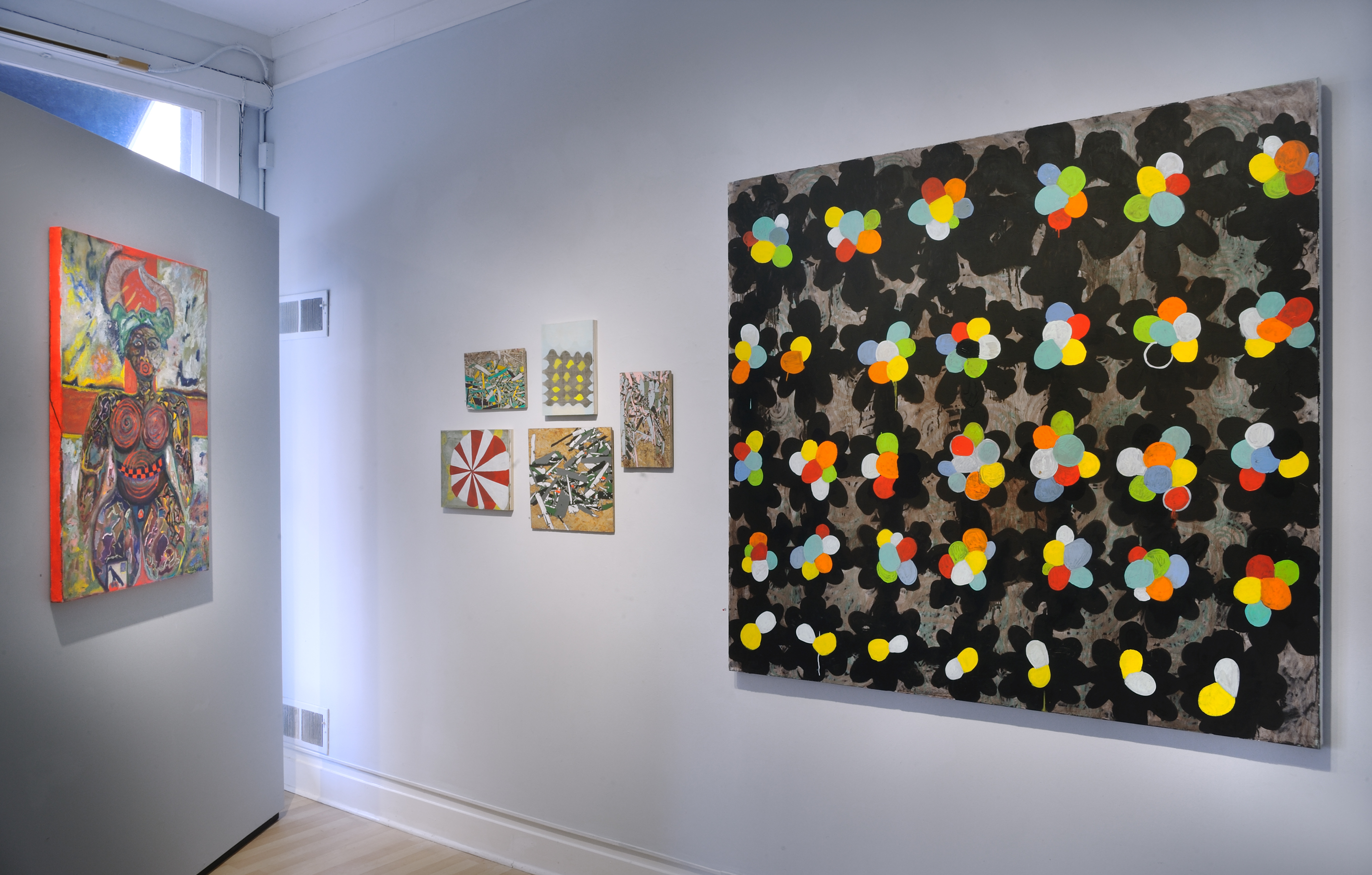
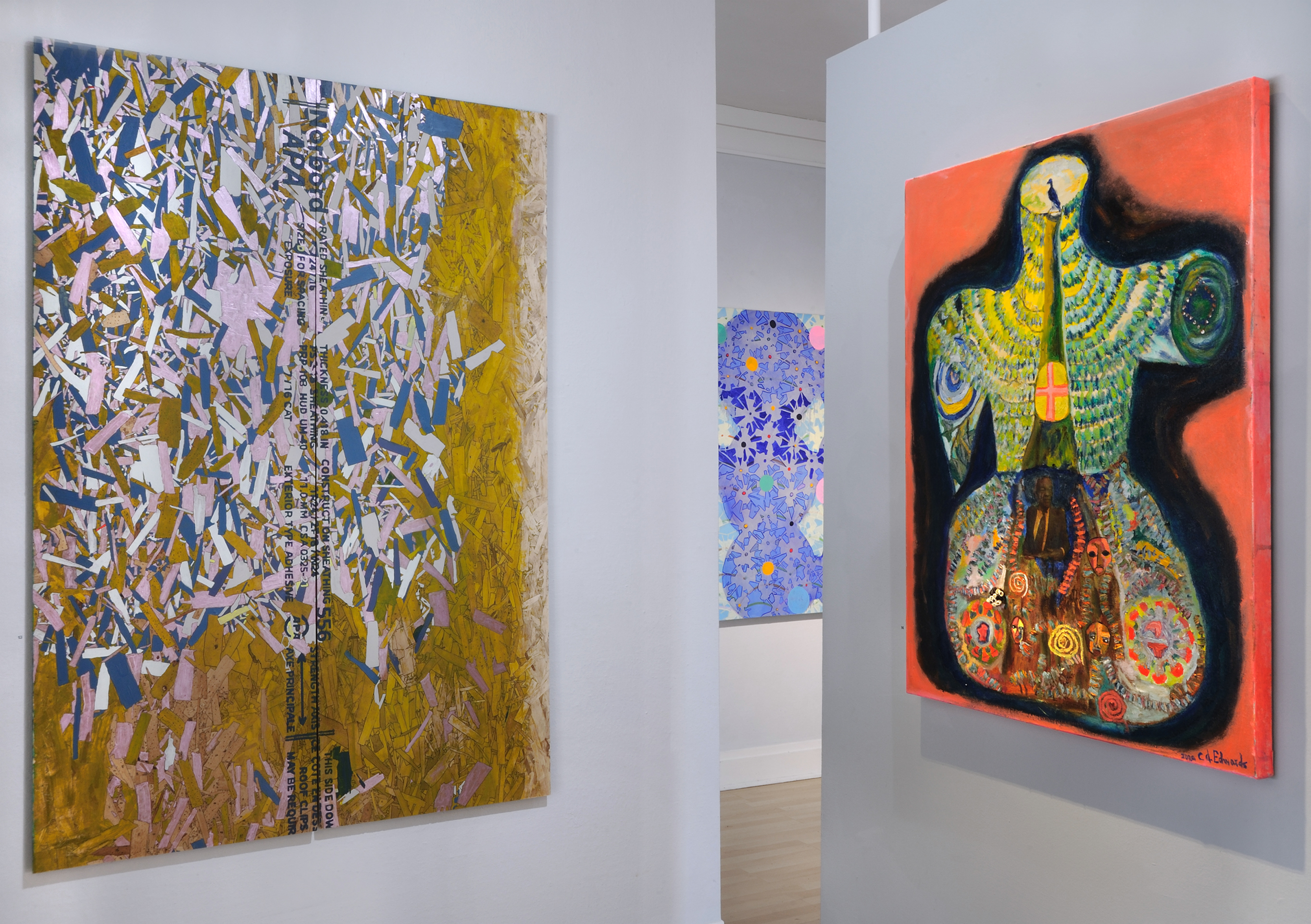
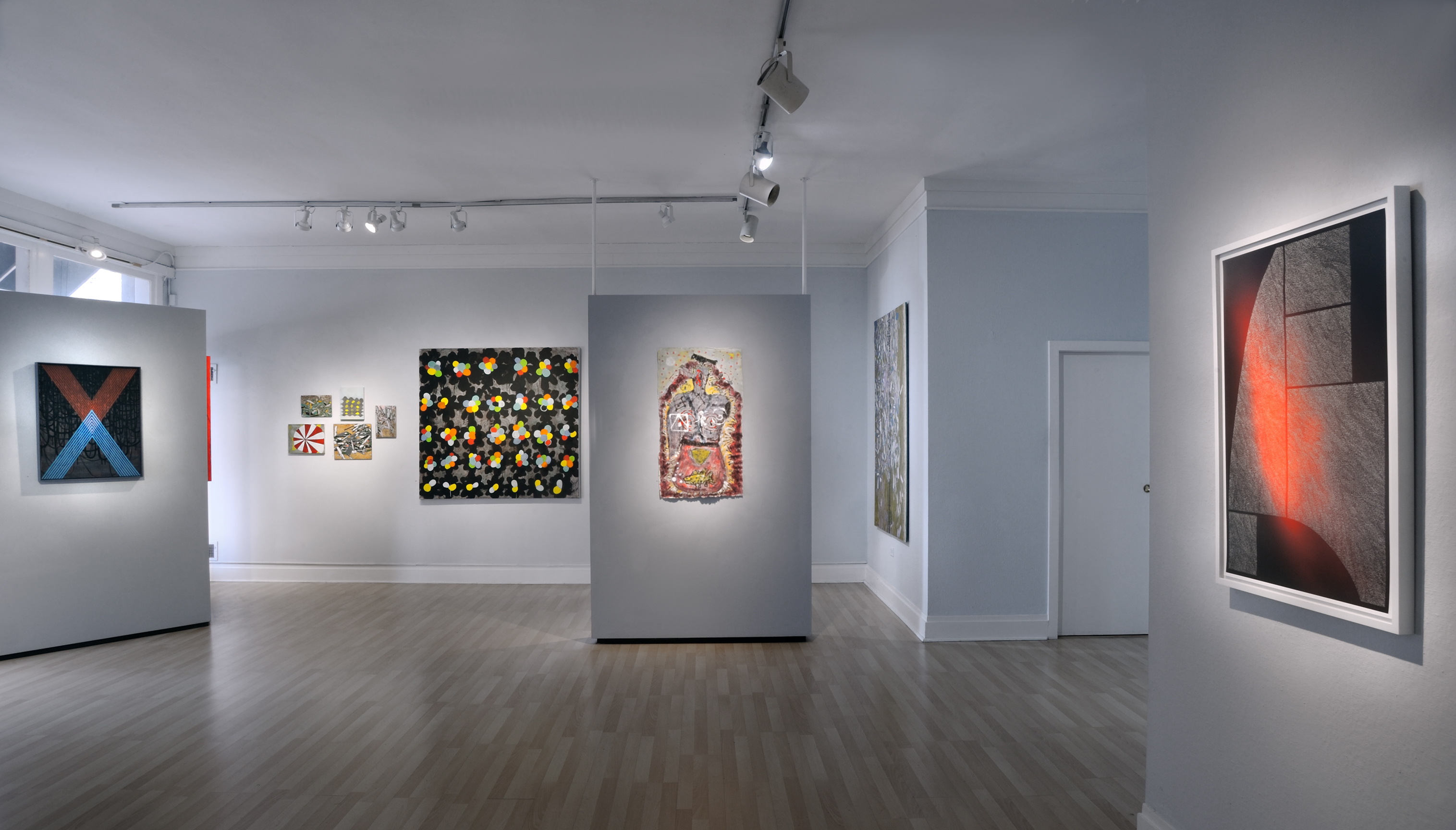

https://www.youtube.com/watch?v=MP9nG5uUyrI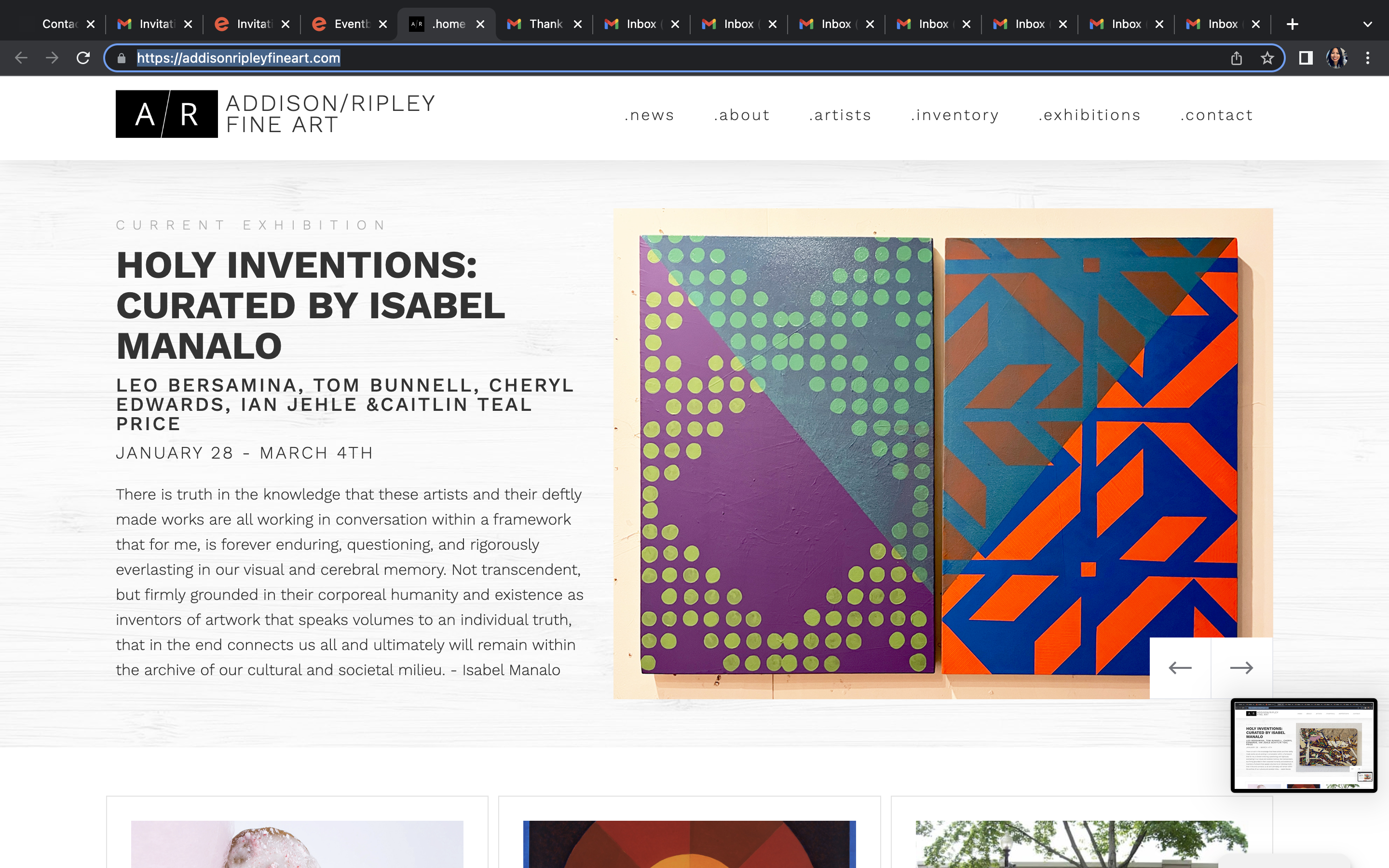
January - Feburary 2022, "Yellow", Student Art Show by select students from Edmund Burke School held at the Dance Loft DC in Washington D.C.
June 15 - August 11, September 3 - October 20, 2019 Solo show of Maia Cruz Palileo, American University Museum at the Katzen Arts Center, Washington D.C.
May 9 - June 20, 2017, (De)Centered: An Exhibition of Filipino American Artists, WAS Gallery, Bethesda, MD
Featuring the work of Filipino American Artists from accross the country: Kimo Nelson, Pamela Ybanez, Ged Merino, Maia Cruz Palileo, Daniel Ballesteros, Alvin Gregorio, Jana Ercilla, Maryrose Mendoza, Melanie Gritzka Del Villar, Matt Manalo, Carlos Ricafort, Jana Anonuevo Langholz, Adrian Alarilla, Isabel Cuenca, Ulysses Duterte, Kimberly Arteche Acebo, Rea Lynn De Guzman, Yumi Yanero Roth.
Curated in collaboration with the Filipino American Artist Directory. www.filamarts.org
December 20, 2013 - January 17, 2014, Bergstraße Window, Berlin, DE
MANUELA MORALES
Materials: Animal fur, plastic, digital prints, old telvisions and video on loop.
Manuela is a Chilean born artist who is currently based in Berlin after finishing a residency at Takt International Artist Residency where I was a visitng artist and curator all last year. I first was introduced to her work while she was working on a body of work addressing notions of displacement and ideas of negative plus a negative amounting to a positive. Her art has the feeling of a science experiment culling images, found objects, and materials and hanging them on her studio wall for future study, manipulation and experimentation.
Not surprisingly, her father is a forensic doctor and his work influenced her greatly growing up. Manuela chose to create an enclosed box in this window space to be the backdrop of symmetry. Two rabbit masks, two framed photographs and two televisions all speaking to one another in dialogue. The audience is challenged to make the connection between the almost comical masks with the apparant clapping politicians all mirroring one another both in print and on film.

December 2013, Manalo Projects at Bergstraße Window, Berlin, DE
JAANIKA PEERNA
Falls of Solitude
Manalo Projects is pleased to announce a new window installation by New York based artist Jaanika Peerna, in Berlin's Mitte district. Jaanika works in a number of mediums including drawing, video and installation. The site specific installation is located in the street front window that is home to a small group of designers and a photographer. It exemplifies Jaanika's ability to move with ease between two and three dimensions. Jaanika's work approaches space in a non-linear fashion. The work positions itself in flux: from a quiet, atmospheric vibration to a wildly kinetic rush. This installation is a continuous flow of mylar paper that pulsates with tension between the material's milky transparency and lightweight qualities, along with the energy of their winding between floor and ceiling. It evokes water in all its movement yet sits quietly, almost solid-like in form.
The unidirectional band of the spotlights accentuate the solidity of the entire body of wound mylar paper, while the diffused natural light that passes through the individual strips allows one to see the ephemeral nature of the individual strips. This intermingling of geometric exactitude and soft pervasiveness in light parallels Jaanika’s use of lines which move between a multitude of strokes and a singular atmosphere. Adjacent to the installation hangs a framed drawing where delicate wax pigment lines create a contrasting dialogue with the physical form of the long strips of tactile mylar paper.

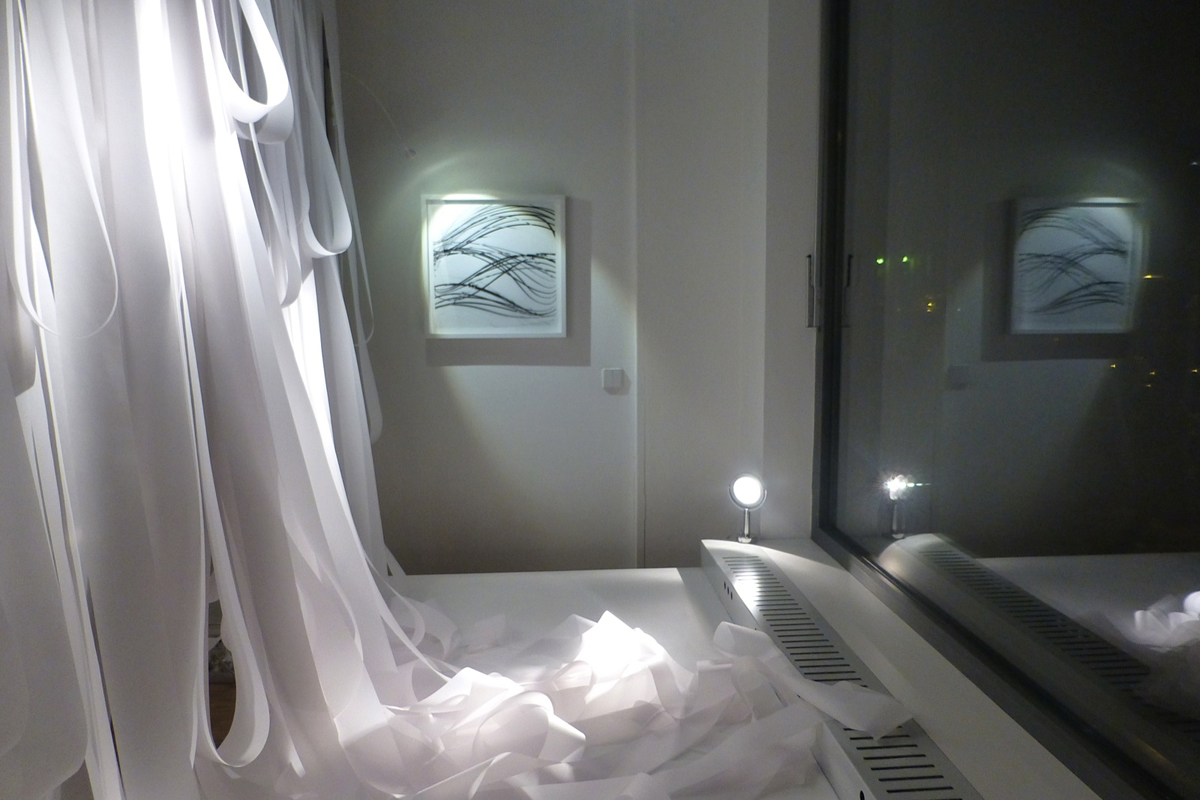 Jaanika Peerna, Falls of Solitude, site specific installation, 200x200x180cm ,tracing paper , tape, lights, 2013
Jaanika Peerna, Falls of Solitude, site specific installation, 200x200x180cm ,tracing paper , tape, lights, 2013
Jaanika giving a talk during the opening/closing of "Falls of Solitude", as seen from the inside.
September 2013, Manalo Projects at Bergstraße Window, Berlin, DE
MEGAN MUELLER
The piece was origianally presented by The Studio Visit's curatorial initiative in 2012 also in Berlin.
Mix media on paper.
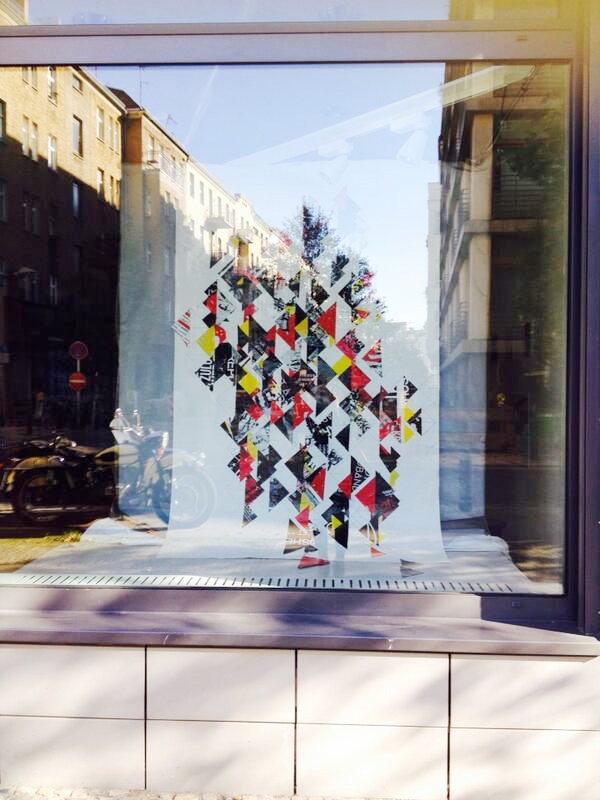
June 2013, Tapir Gallery, Berlin, DE
Natürlich
TAKT ARTISTS IN RESIDENCE
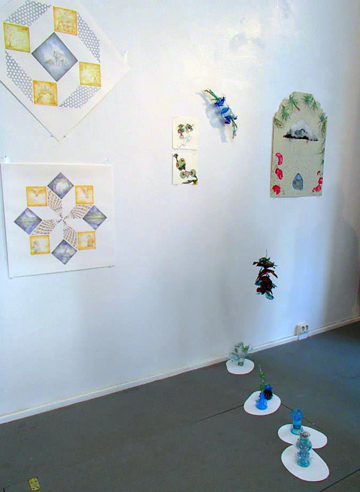
L: Yuria Okamura, Center: Margaret Craig (manipulated plastic sculpture installation), R: Amy Sacksteder
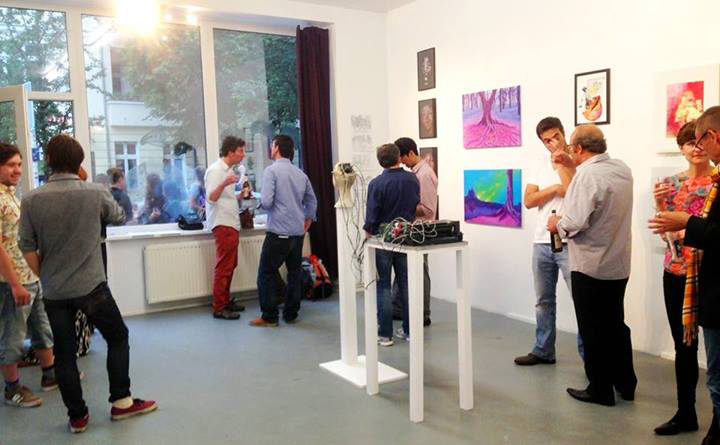
Opening of Natürlich, June 2013, Berlin.
CURATORIAL STATEMENT FOR NATüRLICH:
Of course nature. Playing on the German word that translates to ‘naturally’ or ‘of course’, Natürlich! is an exhibition of works based on my observations and discussions with the spring 2013 Takt resident artists. Over a period of about two and half months, I began to see a common thread coursing through their studios. All of them addressed some concept of nature that is real, imagined or constructed. It is from these valuable critiques in the studios that led me to purposefully choose the specific works made by the seventeen artists in this group that represent and consider nature in a way that is not limited to landscape or the environment but extend to examinations of human nature as it relates to geography, history, psychology, ecology and anthropology.
The bright paintings on canvas of Jack Rowland allude to a fantastical environment from an imagined world where dreaming and despair commingle. Opposite in style and mark are the linear facile works on paper of Bella Rock where worlds are literally exploding and unfolding in multiple narratives as invented creatures come and go. The space of Lindsey Rosalba’s quiet mix media piece is indicative of an artist whose reverence for nature is full of wonder and simplicity using organic materials such as beeswax conjuring a direct olfactory connection to the great outdoors.
Such is the case of Dipti Bondi in her abstract paintings on paper where allusions to light are literally glowing from flashlights within. Yuria Okamura and Amy Sacksteder’s works on paper address a nature where harmony and brewing tension manifest in delicately drawn and painted flora, scape and animalia -- and in Yuria’s work, geometry. Sandra Radic Parac’s mix media tree is an exaltation of found objects and memory. Just as she uses found scraps of wood, artist Margaret Craig collects used plastic bottles for her underwater fauna revealing a process of melting and shaping that ultimately look like blown glass.
And then there is history in nature. Polly Yates culls old photographs from flea markets around Berlin and cuts and weaves abstract forms that force the viewer to come closer and view a fragmented shape interwoven with what once was the representational image of a time long past. Keith Graeme McDougall’s observed drawings from café’s are looser sketches for his satirical graphic novels about 20th century artist George Grosz.
Approaching art as research is the photo montage projection of Franco Bubani, the room installation of Christine Tyler’s cave paintings, drawings and sculptures and Manuela Morales’ digital photos and window adhesive prints. All three are investigating human nature from an anthropological and sociological approach. Franco and his voyeuristic stance of ‘Woman Bedrooms’, Christine’s passion with the Lascaux cave paintings, and Manuela and her personal connection to forensic science as she deftly manipulates prison mug shots that look lurid, macabre and abstract in the end. Jamie Rodriguez’s impressionist plein air painting installation evolves into the political realm in his direct depiction of Sachsenhausen, a concentration camp just north of Berlin.
Leaning towards the psychological, Megan Cole’s portrait paintings endeavor to question notions of ideal and natural beauty as represented in fashion magazines. Liam Mcgarry’s free standing sculpture is self referential. His work treads on the absurdity of human existence as a kind of de ja vu where experiences are repeated over and over again. And surrounding all of this is the sound piece of Mark Dickson whose mixing talent heralds and creates a mood of calm.
It is my pleasure and challenge to have been able to derive a unified idea as represented in these chosen works where ideas and representations of nature are grounded in the human condition. They are all transformative and inventive in their chosen medium and it naturally is evident in this exhibition as they all begin to dialogue with one another in their specific location in the gallery.
Isabel Manalo
September - October 2012, Geschichte 161, Berlin, DE
MEGAN MUELLER AND SAM SCHARF
OUTSIDE IN
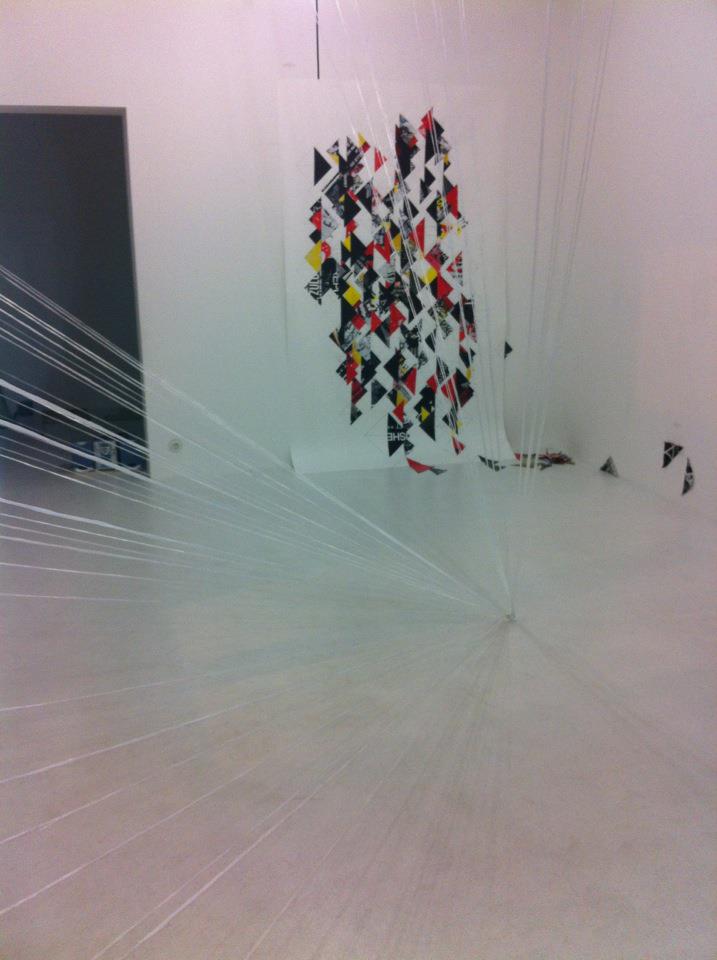 String installation by Sam Scharf and Wall drawing and collage by Megan Mueller
String installation by Sam Scharf and Wall drawing and collage by Megan Mueller
Outside In" is an installation that is responding to their collaborative vision of bringing what they’ve briefly encountered here in Berlin from the exterior environment, and making some kind of order and connection with their experiences from within this new space. Taking advantage of the light from the windows, ceiling lights and the white of the floor, ceiling and walls, Sam chose a material called raffia to redirect the light from a lamp post on the street to the window and then to anchored points on the floor. Raffia is a thin plastic string that is reflective and strong that glistens when pulled taut. Drawn from one light source to another, it literally creates the illusion of the light coursing through its sinewy veins that recalls the strength of a real light beam. Megan’s process involved grabbing and ripping out old wheat pasted posters from the walls of the streets of Berlin that became an action opposite of tagging – a pervasive and iconic form of expression that many associate with Berlin. From these posters, Megan has carefully cut out triangles and thoughtfully recomposed them into an organized dynamic two dimensional collage drawing that is at once meditative, funky and cold. As with the triangular light beams of raffia intersecting the space like some kind of cosmic landing, Megan’s black, yellow and red triangular quilt constructions ring out Deutschland, or more specifically, the colors of the German flag. Intentional or not, it seems to be a rational decision — something that German culture values immensely. There is a dual confidence in their individual choice to choose the crisp line and focus on the geometry of the space to express their connection within and with it. It mimics the asymmetry of the room itself and heralds its sterile nature.
Isabel Manalo
September, 2012
June - July 2011, Addison Ripley Fine Art, Washington D.C.
CULTURESCAPE
LISA BLAS
MEI MEI CHANG
HEDIEH ILCHI
BRIDGET SUE LAMBERT
ELISE RICHMAN

Framed topographical oil paintings by Elise Richman and collages on paper by Lisa Blas
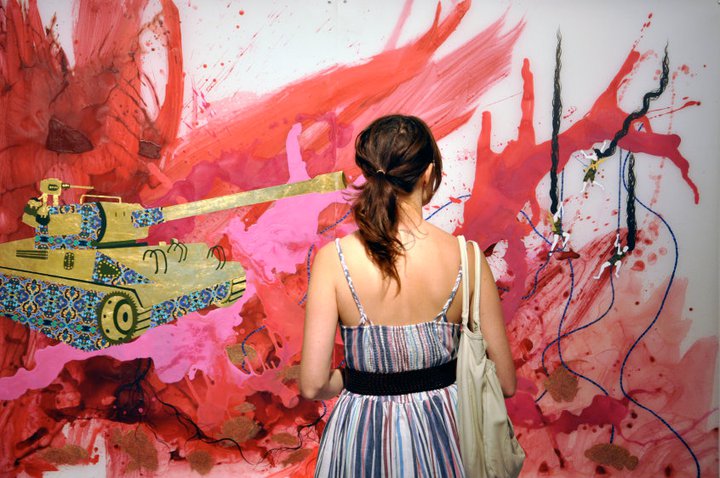
Wall size painting and collage by Hedieh Ilchi
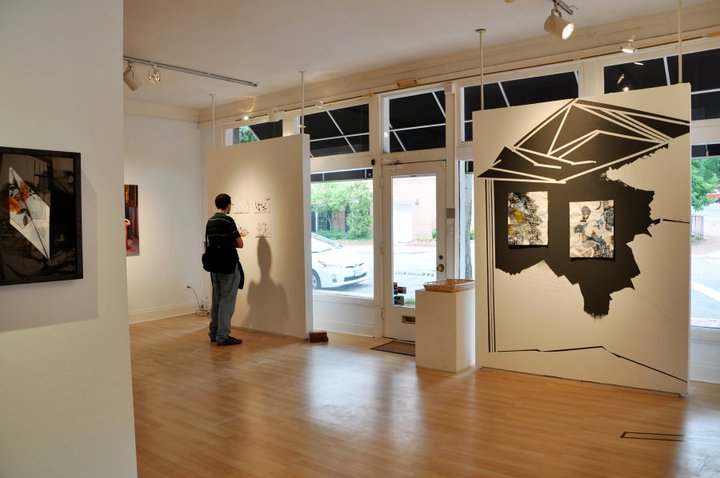
Installation by Mei Mei Chang
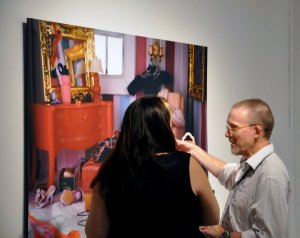
Digital print by Bridget Sue Lambert
The exhibition was on view at Addison Ripley Fine Art in Washington D.C. from June 18 - July 30, 2011. Featured the work by Bridget Sue Lambert, Mei Mei Chang, Hedieh J. Ilchi, Lisa Blas, Elise Richman.
We live in a world where the way we relate with one another and our environment define our varying states of existence. Whether it is intellectual, physical or emotional, in many ways is the inspiration to make art in an attempt to understand what it means to be a part of this world. More specifically to express a feeling or an idea about our own personal narrative that is culled from deep exploration from within ourselves, or from the external environments we live in.
The paintings of Hieronymus Bosch were an early example of an artist who vividly depicted his view of the world as a surreal and confusing place. Contemporary artists Matthew Ritchie and Julie Mehrtu conjure up conceptual worlds of fantasy, discord and chaos by making paintings and drawings that refer to energy, fragmentation and hybridization – all part of the theoretical concepts of a post-modern condition.
The five artists in this show create work that speaks to a similar sensibility yet instead of pointing towards a state of simulacra, their work is generated from a very particularized set of lived experiences addressing change and evolution as it relates to their respective and very focused sense of place, identity and geography. The diversity of their media embodies a spirit of wonderment, resilience and strength as they navigate through areas in their lives that are culturally specific and purposefully unmapped.
Isabel Manalo
May 2011
May - June 2011, District of Columbia Arts Center, Washington D.C.
VICTORIA GREISING
RECOLLECTIONS: MATERIAL, SPACE, MEMORY
 Textile installation by Victoria Greising
Textile installation by Victoria Greising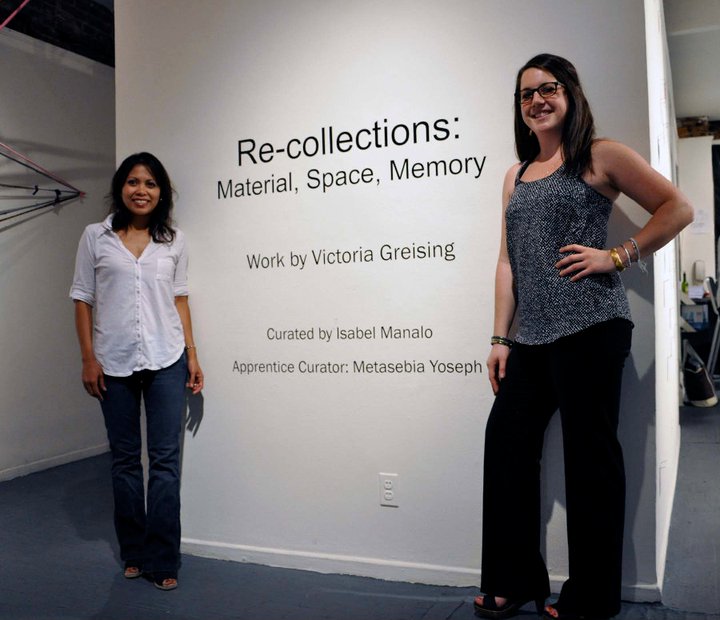
Isabel with artist Victoria Greising, Washington, D.C. 2011
Poet, author and writer Steven Henry Madoff recently stated at a lecture addressing the meaning of space:
"….Great artists make new kinds of hinges for space and time – a new kind of flexibility".
My first encounter with Victoria Greising’s work conjured up that exact thought as I contextualized her work within the age of mechanical reproduction, and more currently, in the age of digital repetition. The use of fabric in her work could be viewed as ‘low tech’, yet the way she creates a discourse around the significance of personal history and material within the surrounding space it occupies, is what Madoff would declare as “breaking the joint”. Conversely to what post-Minimalist sculptor Eva Hesse investigated in her work as a pioneer in her use of unconventional material to convey the idea of the anti-form, Tori is seduced by the form and how it exists in space using textiles not to transcend its ‘objectness’, but rather to imbue it with meaning.
Tori’s webbed installations of manipulated fabric and cord proposes to the viewer an experience that is at once sculptural as well as environmental. These landscapes of collected and woven three dimensional lines elucidate a symbolic coming together of a specific grouping of family and friends, as well as a manifestation of an enigmatic logic of determined handiwork. While many theorized Eva Hesse’s use of material to be evocative and evident of her emotional chaos, Tori’s fabric is charged with confidence and strength. Collected and gathered by numerous friends and family members, each piece is laden with their individual personality and story that informs each decision to knot, weave, cut and pull. The result is an inertial form that beckons us to experience these memories inside and out.
Growing and connecting from wall to ceiling to the floor, the fabrics are stretched, twisted, and tied to create a meshwork of branch like forms, blood veins and muscular tendons that respond to the specific dimensions and particulars of the place. There is a disquieting feeling that you are inside a human body, trapped and claustrophobic. However, within these layers of webbing and weaving, negative spaces part like a mouth to a cave that lure us to cross these thresholds to an unknown place where the outcome becomes liberating and comforting.
Once inside, there may be a pillow beckoning the guest to spend more time, zone out or maybe even take a nap. The light and shadow on the wall further cultivate a hypnotic state of awareness and solitude. A feeling of security sets in akin to being in a fort or a cozy reading nook. Tori surrounds herself with her friends and family as she fills up her life with the fabric remnants of so many people. “Each piece was worn by someone, it maintains a history. It tells a story.”
Tori challenges us to transmute this process of alchemy so we too can contemplate on what is most important – the people that populate our lives.
In a world where there is so much to filter, Tori’s work allows us to be confronted with the present moment– to be launched into a kinetic yet momentary space that is lived, secure and malleable made permanent and tangible by a memory.
Isabel Manalo
April, 2011